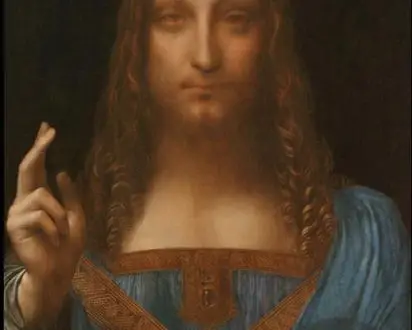Title of Artwork: “Salvator Mundi”

Artwork by Leonardo da Vinci
Year Created 1500
Summary of Salvator Mundi
It is believed that Leonardo da Vinci painted Salvator Mundi (Latin for Savior of the World), which depicts Jesus Christ in the role of Salvator Mundi.
It displays Jesus in Renaissance dress with his right hand uplifted and two fingers extended, while holding a transparent rock crystal orb in his left hand, which symbolises the ‘crystalline sphere’ of heaven and Jesus’ function as a rescuer and master of the cosmos, as depicted in Renaissance art.
There are an estimated 20 other versions of the work that Leonardo’s students and followers are familiar with. Leonardo’s draperies preparatory chalk and ink sketches are housed in the Royal Collection.
All About Salvator Mundi
Originally believed to be a copy of an overpainted original, the painting was repaired and rediscovered before being displayed at the National Gallery in London in 2011–2012 as part of a major Leonardo exhibition. Despite the fact that it has been attributed to Leonardo da Vinci by a number of eminent experts, this claim has been challenged by others.
Leonardo left less than 20 known works, and this is the only one that has remained in a private collection since its discovery. Christie’s in New York sold it on behalf of the Abu Dhabi Department of Culture & Tourism to Prince Badr bin Abdullah bin Mohammed Al Farhan for $450.3 million, making it the most expensive artwork ever sold. The Louvre Abu Dhabi will display the painting when it’s finished.
A painting by Leonardo da Vinci called Salvator Mundi may have been commissioned by Louis XII of France and his wife, Anne of Brittany. After Louis’ conquest of Milan and seizure of Genoa during the Second Italian War, it is likely that this monument was commissioned about the year 1500. In the year 1500, Leonardo himself made the shift from Milan to Florence.
Her private chambers at Greenwich’s Queen’s House appear to have kept it, and it is possible that Henrietta Maria brought it across when she married Charles I in 1625. Leonardus da Vinci pinxit (Latin for “Leonardo da Vinci painted it”) was published in Antwerp in 1650 by Wenceslaus Hollar, who engraved the picture.
It was included in a 1649 Royal Collection inventory and valued at £30 when Charles I was beheaded in 1649 at the conclusion of England’s Civil War. During the English Commonwealth, Charles II’s possessions were sold to pay off debts. The painting was sold to a mason in 1651 and returned to Charles II in 1660, when the English Restoration took place.
It was included in an inventory of Charles II’s possessions at the Palace of Whitehall, which was completed in 1666. Heirs of the estate were inherited by James II of England, who may have given it to his mistress Catherine Sedley, countess of Dorchester, who had an illegitimate daughter with him.
While George III purchased Buckingham House in 1763, the painting was auctioned by Sir Charles Herbert Sheffield, 1st Baronet, his own illegitimate son.
Information Citations
En.wikipedia.org, https://en.wikipedia.org/.






















